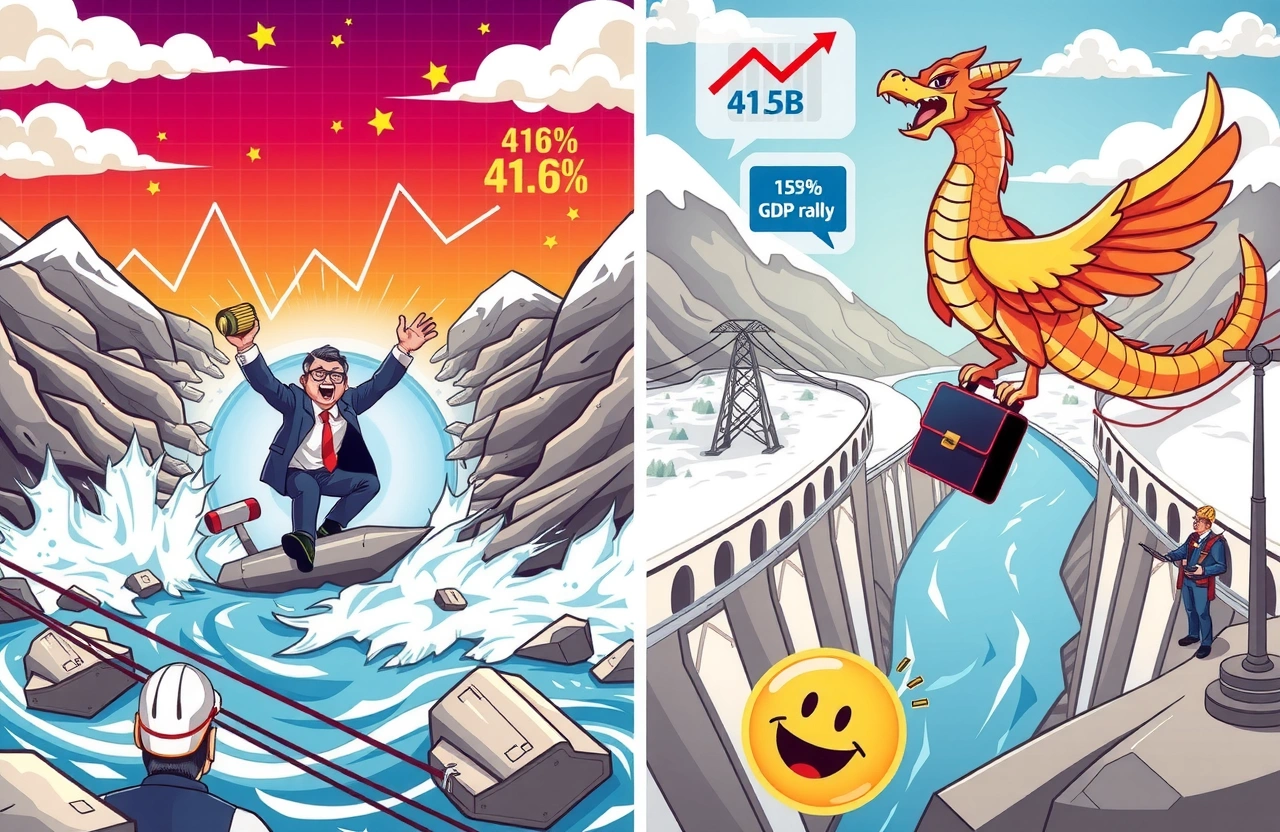China’s stock markets opened strongly on July 21st with robotics and pharmaceutical sectors leading gains while Shangwei New Materials (688585) continued its astonishing rally with another 20% daily limit-up. This marked the ninth consecutive trading session where the specialty chemicals manufacturer saw its stock surge, culminating in a staggering 416% price explosion that stunned investors. The catalyst: CEO Deng Taihua (邓泰华) acquired controlling interest through a ¥2.1 billion ($290 million) deal tied to China’s massive hydropower expansion.
Behind this extraordinary market movement lies the launch of China’s most ambitious renewable energy project—the ¥1.2 trillion ($166 billion) Yarlung Tsangpo hydropower initiative in Tibet. Announced on July 19th, this infrastructure mega-project will construct five cascade power stations harnessing the Tibetan plateau’s immense hydro potential. The hydropower investment boom promises to transform regional economies while accelerating China’s green energy transition, creating ripple effects across dozens of publicly traded companies.
The Nine-Day Wonder: Shangwei New Materials’ Meteoric Rise
Between July 9-21, Shangwei New Materials defied market gravity with unprecedented gains:
- Nine consecutive daily limit-up surges
- 416% price appreciation within two weeks
- ¥21.65 million buy orders queued at peak
The rally ignited when Deng Taihua (邓泰华), founder of robotics firm Zhiyuan, revealed his ¥2.1 billion takeover plan. This strategic pivot positions Shangwei to supply composite materials for hydro turbine components—critical infrastructure needing high-performance polymers resistant to water erosion and extreme pressure.
Behind the Deal: Deng Taihua’s Strategic Pivot
Deng Taihua’s move represents more than a corporate takeover—it signals hydropower’s emergence as China’s next strategic growth frontier. His robotics expertise in automation systems complements Shangwei’s material science capabilities, creating vertical integration opportunities for turbine manufacturing components.
The Hydropower Investment Boom: Transforming Tibet’s Energy Landscape
The July 19th groundbreaking ceremon_y for the Yarlung Tsangpo downstream project marks China’s largest-ever hydropower investment. This hydropower investment boom focuses on:
- Constructing five cascade dams generating 60GW capacity
- Building ultra-high-voltage transmission corridors to eastern provinces
- Creating 200,000 local jobs during construction phase
The National Energy Administration projects the project will supply 300TWh annually—equivalent to Thailand’s entire electricity consumption—bolstering China’s renewable energy mix while reducing coal dependence. Such scale explains why this hydropower investment boom has captured market attention.
Long-Term Economic Impacts
Beyond electricity generation, the hydropower investment boom promises transformative economic benefits:
- For Tibet: 15% projected GDP growth acceleration
- For manufacturers: ¥535-954 billion equipment contracts
- For neighboring countries: Potential cross-border energy sales
Hydropower Concept Stocks: Key Players Positioned for Growth
Nearly 30 publicly traded companies form the core Yarlung Tsangpo hydropower ecosystem with combined market cap of ¥1.15 trillion ($159B). Leading enterprises span these critical sectors:
Tier 1 Infrastructure Champions
- China Energy Engineering: Project lead contractor with specialized high-altitude engineering expertise
- China Communications Construction: Transportation infrastructure for equipment delivery
- Power Construction Corporation of China: Ultra-high-voltage transmission line specialist
Materials & Equipment Providers
- Conch Cement: Tibet’s dominant cement supplier (>65% market share)
- Voith Hydro: Turbine technology partner
- Shanghai Electric: Generator manufacturing leader
Top Performers: Stocks Riding the Hydropower Wave
Several hydropower concept stocks have already demonstrated formidable momentum in 2023:
Market Leaders
- Tibet Tianlu (+48%): Cement monopoly positioned to supply 8+ million tons for dam construction
- Gaozheng Minbao (+53%): Tibetan blasting specialist holding 90% market share
- Sinoma International: Engineering firm involved in geological surveying
Industrial Automation Plays
As construction progresses, demand surges for specialized robotics:
- Estun Automation: Tunnel boring systems
- Siasun Robot & Automation: Remote inspection drones
- Inovance Tech: Turbine control systems
Hydropower Upgrade Technologies Driving Efficiency Gains
The hydropower investment boom accelerates adoption of next-generation hydro technologies:
Digitalization Platforms
- Guodian Nanrui: Smart grid management systems
- Sungrow Power: Hydropower-photovoltaics integration systems
Environmental Mitigation Solutions
- Fish migration systems
- Sediment management technologies
- Micro-habitat preservation tools
Financial Outlook: Assessing Hydropower Stock Valuations
With six listed firms releasing half-year guidance, performance varies significantly:
Profit Growth Leaders
- Huahua Stock: Explosives demand driving 40% forecast EPS gains
- Conch Cement: Regional pricing power boosting margins
- Shengjing Micro: Sensor supplier for monitoring systems
Challenge Areas
- Tibet Urban Investment: Lagging regional infrastructure spending
- Poly Union: Overcapacity in western blasting services
Strategies for Investing in the Hydropower Boom
Hydro investors should prioritize companies demonstrating:
- Pre-existing Tibetan operational footprints
- Technical specialization validated through dam project histories
- Vertical integration across equipment manufacturing chains
Risk Mitigation Approaches
- Geopolitical considerations regarding transboundary water resources
- Construction delays from formidable high-altitude logistics
- Competing provincial allocation priorities
As China accelerates renewable investments to meet carbon neutrality goals, the hydropower investment boom represents more than short-term market excitement—it signifies structural transformation. Forward-looking investors should track quarterly contract announcements and monitor companies demonstrating sustainable technological advantages.
The Yarlung Tsangpo initiative forms merely one component of China’s latest Five-Year Plan targeting 380GW in added renewable capacity. Companies providing essential construction materials, turbine systems, and transmission solutions stand positioned for multi-year growth cycles.
While selective profit-taking inevitably follows volatile breakouts like Shangwei’s remarkable run, this hydropower investment boom promises enduring tailwinds for fundamentally solid enterprises throughout China’s green energy ecosystem.




